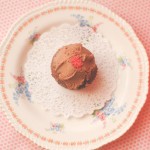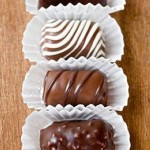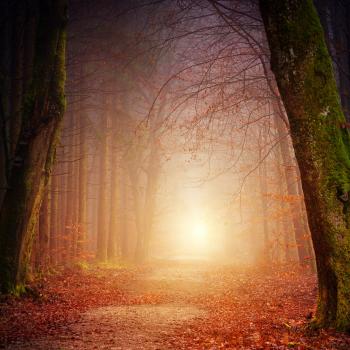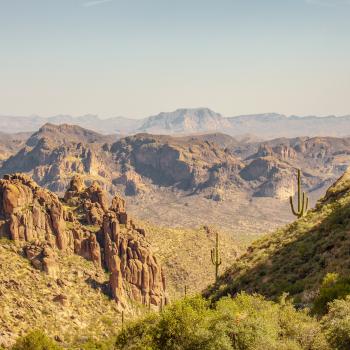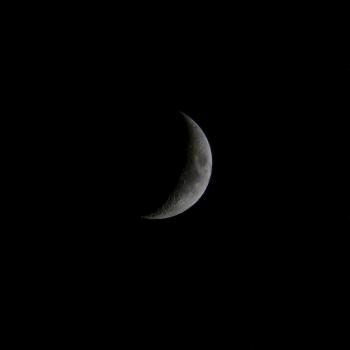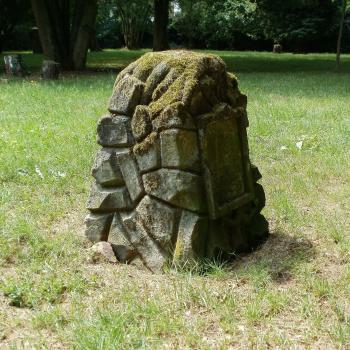[This post will also be a separate page on this blog, for easy access. It can be found here.]
Finally, a long-needed post about the Four Gods that currently rule my life. This post is meant to explain the role each of these gods has within their own deity-family as well as their relation to us. I’ll list epithets as well.
This month I’ll be exploring these gods more in-depth here at Patheos. After all, this is a huge portion of my religious life, and while I could blog about all the drama in the Pagan and polytheist blogosphere (it doesn’t end, it never ends), I have a feeling this will at least be less stressful or exasperating. So, this month, I’ll be writing on the Four Gods of the Otherfaith (the name of their religion), including how they revealed themselves, their relate spirits, and such.
Some of the terms I use are Otherfaith, Other People, Four Gods, and Westernlands.
The Westernlands are the realm that the gods (and their spirits) inhabit. It is seen as layered both slightly above and below our own, and it can be interacted with both in our daily ‘mundane’ life and through journeys (trance and pathwalking). It is an otherworld, more specifically a part of Faery/Fairyland. The Westernlands are both an external landscape and, at times, an internal one. However, when I speak of ‘going to the West’, ‘entering the Westernlands’, or other such statements, it should be understood that such occurs outside of myself (meaning it is not a mindscape).
The Four Gods are the gods residing in the Westernlands. They also inhabit and move in our own world, but we can think of the Westernlands as their home, where their power is at its most potent and raw. These gods are the Laetha, the Ophelia, the Clarene, and the Dierne. We can divide them into male-female camps (Laetha-Dierne as male, Ophelia-Clarene as female) or into elemental associations (Laetha-fire, Ophelia-water, Clarene-earth, and Dierne-air), but those are the most basic and shallow of understandings of the gods. I will delve more into their origins and how those origins affect their relations to spirits and humans in a later post. They are also called the Gods of the West or the gods dwelling Westward.
Other People refers to both the faeries and spirits dwelling in the Westernlands and the humans that ally themselves with those spirits. For example, I could call myself an ‘Other Person’ or ‘one of the Other People’. Someone worshiping or working with the Four Gods and their spirits could call themselves an Other Person. We use this word both because we align ourselves with ‘others’ (faeries) and so that we are more conscious of our own othering – separating ourselves from humans, being different, outside, other – which accompanies interacting with the faeries. (It also ties into dehumanization and rehumanization, but that deserves a separate post.)
Otherfaith is the name of the religion that worships and reveres the Four Gods and related spirits. (It came out of how often I would write, ‘the faith of the Other People…’) It is a new religion and ‘in construction’. It is also a polytheistic faith with emphasis on praxis (practice), though belief is also important as I wrote here. What we emphasize in the Otherfaith is right relationship with the Four Gods, spirits, and fellow humans.
These are all common terms you will see in my writings. Questions are more than welcome and will help me understand what I need to add/what isn’t useful/where more explanation is needed.
Four Gods
the Clarene – sovereignty & home/hearth god (female-oriented)
Symbols:
- lions
- hounds (both black hounds and ‘faery hounds’, which are white with red ears and eyes)
- foxes
- griffins
- tea & coffee
- orchards
- tall trees (sequoias, Douglas firs, Redwoods, etc.)
- skyscrapers
the Clarene is also called the Orchard-Picker, due to her focus on orchards and gardens. She is associated with agriculture and healthy cultivation of the land, as well as cities. (In the mythos of the Other People, she forms the first city by breaking off her bones and setting them up in the land, creating skyscrapers.) She is also associated strongly with birth and burial – she creates spirits and animals from the land as well as buries them. She has appeared visually both as a dark skinned woman with hounds running beside her and fruits in her arms and as a pale, golden colored woman offering golden apples. She is tied most strongly to humanity out of all the Four Gods and most likely to offer comfort in stressful situations. Her sacred number is three.
Epithets:
- Orchard-Picker/Orchard-Tender
- Lady of Lions
- Mother of the Mirror
- Horned Lion
- the Singer
- Keeper at the Gate
- Book Hoarder
- Horse-Rider
- Chimera-Crafter
- King-Maker
the Ophelia – river & time god (female-oriented)
Symbols:
- lakes
- ocean monsters
- blue colors, especially clothes
- skulls
- blue or black colored birds
- rain
- wolves
the Ophelia presides over sadness, despondency, and grief, as well as any ‘dark’ turbulent emotions. In her mythos, she becomes King and God through death and worship by the spirits, allowing her to return and serve them as a keeper of time. As such, she presides over time, keeping time flowing correctly (time is also connected to her River in the otherworld; here in the physical world, she is able to be where any river or lake is), and also in charge of death. She is a difficult god in that she pushes for us to change and never stagnate; she is also, however, a comforter and represents some forms of parentage, mostly in soothing and nurturing forms. She usually brings a very present sad energy when she manifests. She visualizes sometimes as a woman made entirely of water, a pale woman with dark hair and eyes and water dripping from elaborate robes, or a dark haired woman wearing a mask with tear trails carved into the wood. Her sacred numbers are four and seven.
Epithets:
- Bluebird
- Lady of Shrouds/Veils/Silk
- Lady of Sorrows/Sadness
- Well at the End of the World
- Blue Peacock/Peacock
- Mother Ocean
- the River
- Blue Queen
the Laetha – fire & seership god (male-oriented)
Symbols:
- fire
- phoenixes
- poppies
- rubies
- red birds
- hearts
the Laetha represents all mortals who wander into Faeryland and become lost, trapped, or otherwise stuck in the otherworld. He is especially associated with fire – wildfire especially, as well as hearth fires – and helps with divination and oracular work and trance. He inspires us to passion and anger and too quick decisions. He and the Ophelia are seen as combatants, as she represents ‘dark’ turbulence and the Firebird represents ‘light’/joyful turbulent emotions. He appears both as a glimmering human man with red hair and colorless eyes (usually accompanied by the scent of some sort of cleaning solution) and as a huge bird made out of fire and flames. He is also associated with songs and bird cries. His sacred numbers are 13 and 2.
Epithets:
- Firebird
- the Mortal
- Red Peacock
- Asier
- Sundered God
- Mortal-Made-More
- Calamity of the West
the Dierne – celestial & death god (male-oriented)
Symbols:
- stars
- wolves
- peacocks
- crowns
- blood
- roses
- silver
the Dierne is a god of love, fallen stars, and sex and/or romance. He shares dominion of romance and sex with the Laetha, but whereas the Laetha is more focused on romance, the Dierne has a more intense focus on sexual activity. He is seen as the culler of damaging relationships (friendship or romance). He is also associated with storms and playfulness, and his other name – Star-Wind – reflects his ties to wind (breezes, sharp kicks of wind, anything). He is seen as a bridger of worlds – celestial and earth, mortal and fae. He occasionally takes on war deity qualities. He is tied to pleasure (sexual or not) and excess, and diamonds are another common symbol. He appears as a tall, thin young man with dark hair or as a young man made entirely of glittering dark lights. His sacred numbers are 13, 12, and 4.
Epithets:
- Star-Wind
- Boy Before Stars/Boy Beloved of Stars
- Forgotten Boy
- Second Star
- Undying Youth
- White Peacock
- Thunder-Boy
- Lightning-Rider
- Pallis
- Fear*
(You can find more for the Dierne here.)
As stated, questions are welcome.

